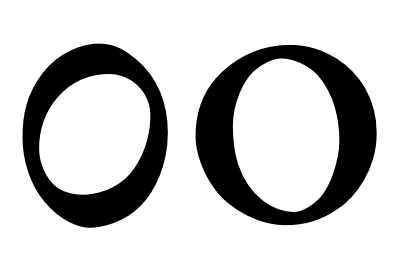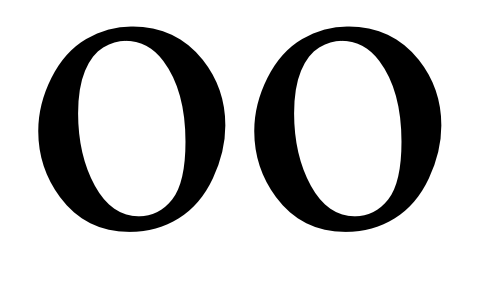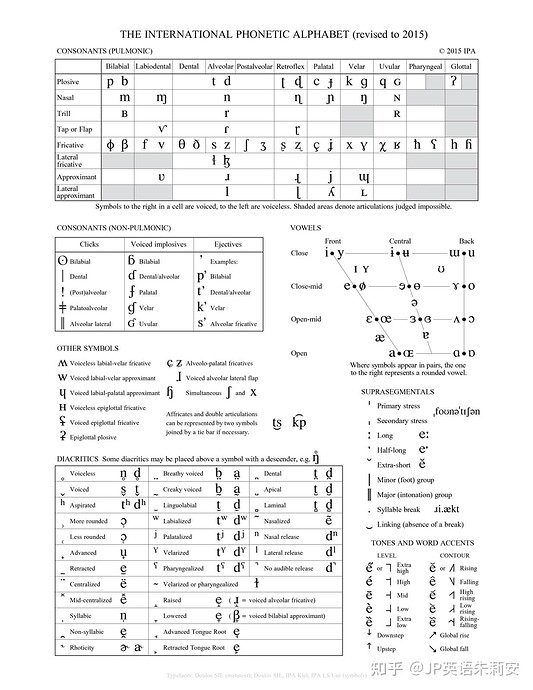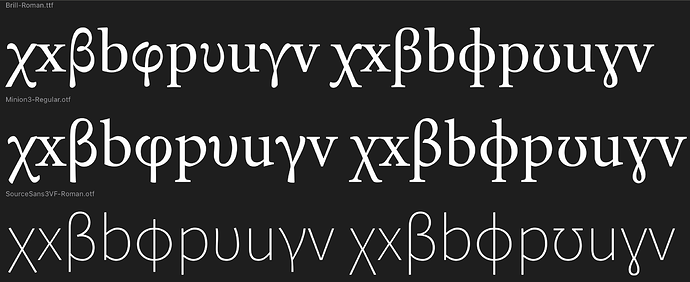Why is there no ‘z’?
Also does not contain the international phonetic alphabet extents of all characters.Whether need to modify your word table?
IPA English charts — 国际音标英文图表 (internationalphoneticassociation.org)
How to find out all the characters that need to be used in IPA?
Unicode characters in IPA is kinda odd, as many of them are recycling the existing Latin and Greek characters. Greek χ and IPA χ share the same code, for example. Likewise, the IPA z is just Latin lowercase z.
In case of chi, there are both a Greek character χ (U+03C7) and a Latin character ꭓ (U+AB53) in Unicode.
That depends on how extensively your font should support IPA. There are various extensions to the core characters, some more standardized than others. IPA also makes extensive use of marks that combine with the base IPA glyphs is various ways.
True, but I understand the one used for IPA is the Greek one.
Thank you. I have found all the characters that are officially used in IPA in CHATGPT. So I can eliminate letters I don’t need.
thank you。
The Greek character χ (U+03C7) is a commonly used symbol in the International Phonetic Alphabet (IPA), used to represent a velar fricative sound, with the corresponding IPA symbol /χ/. This symbol is widely used in the IPA and appears in the phoneme charts of many languages.
On the other hand, the Latin character ꭓ (U+AB53) is not used in the International Phonetic Alphabet. It is a character added to the extended Latin alphabet in Unicode version 8.0. This character has a very limited usage and only appears in some specific dialect transcriptions. It is not used in regular IPA transcriptions.
It should be noted that most of the symbols used in the IPA are existing characters in the Unicode character set, rather than specially added characters. Therefore, when transcribing in the IPA, it is usually only necessary to use characters that already exist in the Unicode character set.
Glyphs seems to put the Latin character ꭓ (U+AB53) into the International Phonetic Alphabet, which is a mistake, it should be a Greek letter。
The Latin character ꭓ (U+AB53) is located in a relatively new block in the Unicode character set, namely the Latin Extended-E block. This block contains a range of characters specifically designed for the extension of Latin letters, including additional diacritical marks, letter variants, and special characters. The block is assigned to Unicode code points U+AB30 to U+AB6F.
Why would U+AB53 not be usable in IPA text?
Being able to differentiate between Greek and Latin characters can be useful if a font supports both Latin and Greek as well as IPA. Then, the Greek letters used for IPA set amidst Latin letters might not fit stylistically while the Latin versions of those Greek letters would.
This can also be achieved by substituting the Greek letters to alternative glyphs that fit better among Latin letters using the IPPH script in OpenType feature code, but software support for that is very limited.
Because the χ used in IPA (for instance for the German ch after posterior vowels, such as in “Bach”, same as the non-voiced French r in words like “prof”) is the Greek symbol. Why would you use a different unicode character? This only becomes confusing, especially since (as previously pointed out) most of IPA is based on existing Latin characters, you wouldn’t want to use different codepoints for representing the exact same symbol.
Small fun fact: my phonetics professor wrongly used the double-storey (Calibri default) g in her transcriptions, this is a case where a separate codepoint for the explicitly single-storey g (the only one that exists in IPA, the double-storey one doesn’t) makes sense.
Because they are not used as Greek but as Latin characters. Their design origin is Greek, but that also applies to many other Latin letters.
See: IPA support, Greek letters in IPA, IPA small caps, and display typefaces — TypeDrawers
In text interchange, the code level can cause confusion.
What Florian was trying to explain is that the style of Latin and Greek letters can differ quite a bit even in the same font (Latin has a more vertical stress and Greek can have a horizontal stress). So having a font that supports Latin Greek and IPA, where the χ uses the greek style in between Latin glyphs would look strange.
To demonstrate the difference in stress, this is the omicron and the o from Adobe Garamond Pro:

So it would be typographically better to have a different χ for use use in IPA that matches the latin and one that is proper greek.
A lot fonts “avoid” the problem by using a latinized Greek.
The same letters in Times New Roman:

But you are right, we need to build fonts that work with the texts in use by people.
Georg is right in that a picture is probably a better message than just abstract code points.
Here is χxβbφpυuγvε ꭓxꞵbɸpʊuɣvɛ (Latin-Greek mix left, Latin right):
Code points
U+03C7 GREEK SMALL LETTER CHI
U+0078 LATIN SMALL LETTER X
U+03B2 GREEK SMALL LETTER BETA
U+0062 LATIN SMALL LETTER B
U+03C6 GREEK SMALL LETTER PHI
U+0070 LATIN SMALL LETTER P
U+03C5 GREEK SMALL LETTER UPSILON
U+0075 LATIN SMALL LETTER U
U+03B3 GREEK SMALL LETTER GAMMA
U+0076 LATIN SMALL LETTER V
U+0020 SPACE
U+AB53 LATIN SMALL LETTER CHI
U+0078 LATIN SMALL LETTER X
U+A7B5 LATIN SMALL LETTER BETA
U+0062 LATIN SMALL LETTER B
U+0278 LATIN SMALL LETTER PHI
U+0070 LATIN SMALL LETTER P
U+028A LATIN SMALL LETTER UPSILON
U+0075 LATIN SMALL LETTER U
U+0263 LATIN SMALL LETTER GAMMA
U+0076 LATIN SMALL LETTER V
These are all 172 characters used by IPA :
pbtdʈɖckqɂmɱnŋrⱱɾɽfvðszʃʒʂʐçʝxħhɦɬɮʋɹjlʎʘɓʼɗʄɠʍɕʑwɥɧʡ̥̤̪̬̰̼̻̃͜ᶰ̟ᶫ̴̠̝̩̞̘̈̽̚˞̙iyʉɯueøɘɵɤoəɛœʌɔæɐaˈ̆|.‿̌́̂̄᷄̀᷅᷈ꜜ↗ꜛ↘ǀǁǂǃɑɒɜɞɟɡɢɣɨɪɭɰɲɳɴɶɸɺɻʀʁʊʏʔʕʙʛʜʟʢʰʲʷˌːˑˠˡˤ˥˦˧˨˩̜̯̹̺̋̏͡βθχ‖◌
International Phonetic Alphabet symbols should not be included in the Latin alphabet, but rather should be a separate character set. The characters used in International Phonetic Alphabet are scattered across many Unicode blocks.
This is not the right platform to discuss that (Unicode Consortium is) and it’s certainly not a new topic. And having seen how things have gone, I do not think the IPA situation is going to change.
And if I were a Unicode Consortium member designing the IPA block at the time, I kinda agree with the decision; why wouldn’t I reuse the letters that already exist? There are some cases like chi that could be added, but otherwise it would make sense. You’ve got to admit, IPA is a Latin-based system.
Thanks a lot for this simple, but effective example (same goes for Florian’s screenshot). The degree of diversion and visual mess that causes simply hadn’t occured to me.
I’m still curious, how do people actually write IPA in a practical setting? Pick glyphs from the InDesign glyph panel? Is there an IPA input method?
@SCarewe IPA users use input methods like those listed on SIL’s IPA Unicode keyboards page, for example Keyman’s IPA (SIL) keyboard or the IPA SIL keyboard. or use webapps like TypeIt or Richard Ishida’s Pickers (IPA, IPA2, IPA3). One can also make their own custom keyboard layout or app to get input from. Some people also use LaTeX’s TIPA system or translate from XSAMPA with a tool.
@wstytdzj No, IPA is Latin.
See Unicode 15.0 chapter 7:
The Latin script is used to write or transliterate texts in a wide variety of languages. The International Phonetic Alphabet (IPA) is an extension of the Latin alphabet, enabling it to represent the phonetics of all languages. Other Latin phonetic extensions are used for the Uralic Phonetic Alphabet and the Teuthonista transcription system.
The International Phonetic Association has always used the Latin characters already in Unicode when they were already there. Latin beta A7B5 ꞵ and Latin chi AB53 ꭓ were only relatively recently added to Unicode to represent letters disunified from the Greek characters because of case pairs, A7B4 Ꞵ / A7B5 ꞵ and A7B3 Ꭓ / AB53 ꭓ.
Already before they were disunified, in IPA the Greek characters β and χ should in theory look like Latin letters instead of like Greek letters. There was a strong intention of the IPA, under Daniel Jones, to have Latin letters. Jones was also influencial in the adoption of many IPA symbols into the International African Alphabet that ended being used in several African language orthographies with case pairs.
Unicode ended disunifying what was deemed necessary in early versions for ɑ ɣ ɛ ɩ ɪ ɸ ʋ ʊ and only after evidence was provided in those two cases. Unicode block are more a reflection of the encoding history than actual uses.
There is plenty of IPA data that uses Greek characters even if the IPA has documented what Latin characters to use instead (see John Wells’ IPA in Unicode page or the IPA Handbook).
There is already a bit of, and I guess there will be more, IPA data using the Unicode 8.0 Latin A7B5 ꞵ AB53 ꭓ. Maybe the IPA will make them official, maybe not.

